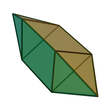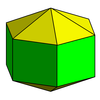Elongated bipyramid
| Set of elongated Trapezohedra | |
|---|---|
 | |
| Faces | 2n triangles, n squares |
| Edges | 5n |
| Vertices | 2n+2 |
| Symmetry group | Dnh, [n,2], (*n22) |
| Rotation group | Dn, [n,2]+, (n22) |
| Dual polyhedron | bifrustums |
| Properties | convex |
In geometry, the elongated bipyramids are an infinite set of polyhedra, constructed by elongating an n-gonal bipyramid (by inserting an n-gonal prism between its congruent halves).
There are three elongated bipyramids that are Johnson solids made from regular triangles and squares. Higher forms can be constructed with isosceles triangles.
Forms[]
| Name | J14 | J15 | J16 | elongated hexagonal bipyramid |
|---|---|---|---|---|
| Type | Equilateral | Irregular | ||
| Image | 
|

|

|

|
| Faces | 6 triangles, 3 squares |
8 triangles, 4 squares |
10 triangles, 5 squares |
12 triangles, 6 squares |
| Dual | triangular bifrustum | square bifrustum | pentagonal bifrustum | hexagonal bifrustum |
See also[]
References[]
- Norman W. Johnson, "Convex Solids with Regular Faces", Canadian Journal of Mathematics, 18, 1966, pages 169–200. Contains the original enumeration of the 92 solids and the conjecture that there are no others.
- Victor A. Zalgaller (1969). Convex Polyhedra with Regular Faces. Consultants Bureau. No ISBN. The first proof that there are only 92 Johnson solids.
Categories:
- Pyramids and bipyramids
- Polyhedron stubs